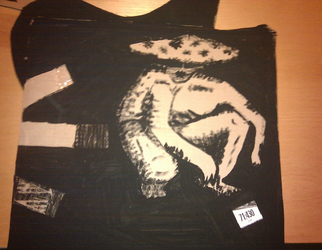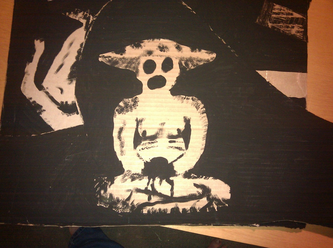|
The Breadcrumbs widget will appear here on the published site.
P'burgh's 'Creative Urbanist'By Christine Stoddard QuailBellMagazine.com I first met Connor Sites-Bowen at The Cyberpunk Apocalypse Writers' Project one evening in January. The event was the cooperative's monthly Cool-Off, a sort of show-and-tell for artists, writers, and community artists in Pittsburgh. Connor and I immediately started chatting. Soon, I found him to be an engaging and curious fellow. A graduate of Carnegie Mellon University and an Americorps food bank worker, Connor fell in love with Pittsburgh early on in his college career and wants nothing more but to nurture and explore the city. His recent project--a form of combined urban and environmental art--highlights his unique gift for seeing potential in a post-industrial city. Who are you and what do you do? You may, of course, identify yourself with your superhero name.
Connor Sites-Bowen, Creative Urbanist and general appreciator of the weird, the strange, and the forgotten. Tell me about your highly imaginative/pseudo science fiction project! It's about mushrooms and urban decay. What's it called? Strangely enough, they don't really have a name. They are less a specific, targeted, nameable piece, and more like This Thing I Do. What This Thing I Do is, physically, is a series of paintings of figures, generally fungal, in black tempura, on cardboard, which I install, or give out to others to install for me, in decaying buildings around Pittsburgh that I wish to see digested and revived. So, why mushrooms? Why not...worms, for instance? Mushrooms and other fungi do this amazing thing when they need food. They emit or secrete enzymes into their environment that take the material around them and begin to break it down. They keep doing this until the material is, effectively, one step from being mushroom-flesh, at which point the fungal mass emits thousands or millions of cell-tentacles called mycelium which surround and encase the nutritious material, and quickly turn it into more fungal growth. It is only when their environment becomes too harsh and there is nothing left to break down and consume that fungi send tentacles of mycelium up to the surface, where they produce what we think of as "mushrooms"--many of which are poison-laced, so as to, hopefully, kill the creatures that eat them and produce more organic material to digest. Once a fungus has run its course, it leaves soil that other plants can easily grow in. Pittsburgh's decaying infrastructure and abandoned buildings are ripe with metaphors about that process, and I wanted to make something that would capture those poetic thoughts about change, decay, renewal, etc in physical form. I see such forces at work already, so I simply gave them a physical form. Talk to me about the your creative approach to this project. How did you come up with this idea and how do you execute it? Ever since I moved to Pittsburgh, I've thought of it as a totally creepy, decaying place. The empty steel mills, the strange, potholed streets to nowhere, the ancient brick Victorian houses, the city-owned steps that connect different neighborhoods, all of it rolls together into one big, strange, weird city. Combine that with a rather insomniacal undergradute experience [at Carnegie Mellon University], and the idea of the city as one huge organism, or an ecosystem, every pore and gill brimming with delightful, disgustingly specific lifeforms, from bottlecaps to skyscrapers, came pretty easily. The excecution is half high-theory, half practicality. The high theory part is that, like fungi, my materials (tempera paint and cardboard) are temporary, fleeting things that will themselves be broken down by time, weather, etc. They are also natural pieces of the urban environment- cardboard is an essential kind of urban trash, and cheap paint is, well, universally available in cities. I don't even know where my first tempera bottle came from; it just arrived in my life. The practicality part is that tempera and cardboard are cheap, and I don't feel bad or weird or fake trying to use them. They are a humble, almost scratch-paper-like medium. How do you choose your buildings? Easy. The pieces I have placed, I placed in run-down buildings that I've been watching for years. I've had for years a running list of run-down places around the city ready for art-bombing. As I create the pieces, each one seems, upon completion, to have a natural place to go to from that list. The works other people place, I hope come from similar internal notions. How long do you keep your work in these buildings? Why is this amount of time significant? Until the same forces that are slowly destroying the buildings destroy the work. What's so special about Pittsburgh? Would this project work as well in other cities? Really any place would work, as long as there is some amount of human-created decay: abandoned train tracks, old highways, temple ruins, etc. Pittsburgh works well for them because it has a large concentration of abandonment, decay, and general desecration. I could see pieces in other rust belt cities (Buffalo, Detroit, Worcester, Cleavland, etc.) with little or no change. How many pieces have you done so far? How long do you intend to do this? It's been a busy year with other things, so there are only 20 or so right now. I make more as I have, or carve out, time. There is no strong end date yet. Has the community responded to your project at all? What has the response been like? I haven't heard or read anything yet. My secret hope is that, in the middle of the night, walking home from a long, possibly terrible evening out, some half-drunk stranger catches a glimpse of one of them in the dark. I hope that, at that point, the cardboard has gotten wet and started to melt and fall apart, and that this person CANNOT tell if the horrible, black-eyed figure they see was even made by a human, and not just a figment of their drunken, exhausted mind. Update: On April 21, 2011, Connor stopped by three of the places he had put his paintings--and they were all gone! CommentsComments are closed.
|
|

















